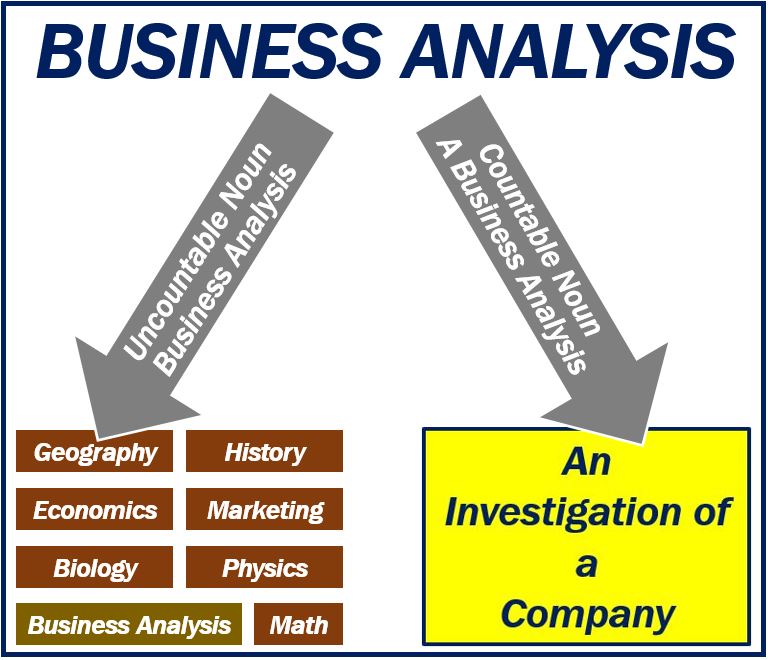A business analysis is an investigation into a company’s operations. The aim is to determine what caused the results it achieved as well as those results’ effects on the business.
Business analysis is also a research discipline. It identifies a business enterprise’s needs and determines solutions to problems related to business. This discipline encompasses a variety of techniques and methods used to analyze and evaluate complex data and processes within an organization. Experts in this field are business analysts.
Business analysis – countable & uncountable noun

A countable noun has the word ‘a’ before it while an uncountable noun does not. ‘Water,’ for example, is an uncountable noun, while ‘bottle’ is countable. We can say one bottle, two bottles, etc., but we cannot say one water, two waters, etc.
When the term ‘business analysis’ is uncountable it is a discipline, when it is countable it is an investigation.
What is a business analysis about?
A business analysis is all about gaining a better understanding of how a company operates to achieve its purposes.
During the investigation, you try to define what the business requires to provide goods or services to the external stakeholders.
It is important to find out how the business’ goals and objectives connect. After carrying out the analysis, you need to make a plan showing how the company can achieve its goals and objectives.
Your goals state how you want your business to be while your objectives state how you plan to get there.
Effectively aligning these goals and objectives through business analysis can significantly enhance operational efficiency and market competitiveness.
Steps of a business analysis
Step 1: Define the scope and objectives
What’s the problem with your business? That’s where you should start: by defining the problem or opportunity you want to address. This requires you to go over the organization’s core objectives, stakeholder expectations, and goals the analysis should achieve. Also, determine who the relevant stakeholders are as their input will guide the direction of the analysis.
2. Gather and analyze Information
Collect as much data as you can about the business. This may include reviewing existing documents as well as conducting interviews and surveys.
Visualize and map current business processes to see if there are any inefficiencies or areas for improvement. Understanding the existing workflows is essential before suggesting changes.
3. Identify requirements and possible solutions
Translate the issues and stakeholder needs into measurable requirements. These requirements describe what a solution must accomplish to address issues. Work with your team to explore different approaches and evaluate their potential to solve the issues you’re trying to tackle.
4. Evaluate and prioritize solutions
Assess the feasibility of each potential solution. Then rank the solutions based on their expected benefits and strategic fit. The goal is to target the ones that offer the greatest impact.
5. Present recommendations
Clearly document your analysis, including the methods used, data gathered, and insights gained. You should then present your recommended solution(s) along with an implementation plan detailing timelines, cost estimates, and potential risks.
6. Implement and monitor
Roll out the chosen solutions. You can establish key performance indicators (KPIs) and metrics to measure the effectiveness of the plan.
Video explanation
This educational video explains what a ‘Business Analysis’ is using simple and easy-to-understand language and examples.
